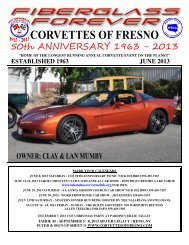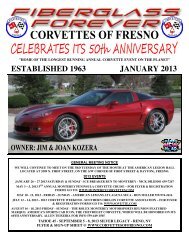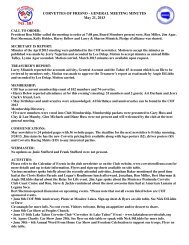corvettes of fresno - Description: Description: Description ...
corvettes of fresno - Description: Description: Description ...
corvettes of fresno - Description: Description: Description ...
Create successful ePaper yourself
Turn your PDF publications into a flip-book with our unique Google optimized e-Paper software.
1997 - early 2001 Battery Acid Leakage Issue<br />
All 1997 to 2000 C5's have a very potential battery leakage problem. The problem isn't so much that the<br />
battery leaks, but that it leaks on the computer, wiring harness, frame and one vacuum hose for the A/C<br />
controls. The battery tray is open in the center, and will direct the acid straight onto your computer! This<br />
can become an expensive repair, and is NOT covered by any extended warranty. If you have not already<br />
done so, replace your battery with either a Optima Redtop or the ACDelco AGM 78P-7YR (List $149, I paid<br />
$101.99). Make special note <strong>of</strong> the P in the part number. This is what specifies that this battery is a AGM<br />
(Absorbant Glass Mat) AGM is a newer type <strong>of</strong> battery construction that uses saturated absorbent glass<br />
mats rather than gelled or liquid electrolyte. They will not leak acid.<br />
At some point in 2001, GM started to use the newer AGM batteries with a GM part number <strong>of</strong> 75P-7YR. The<br />
battery tray size also changed to slightly smaller size. Thus the reason that this is<br />
only an issue with earlier C5's.<br />
I was also given a brass washer to put on the positive battery post from my GM parts guy. He stated that<br />
the problem with the batteries is the positive battery cable's bolt acts as a puller, and will actually pull the<br />
terminal out <strong>of</strong> the battery dumping acid. While probably not needed the AGM battery, I would still<br />
recommend it.<br />
ACDelco Battery Specs :<br />
1997 - early-2001 78P-7YR 650 CCA<br />
early-2001 - present 75P-7YR 550<br />
CCA<br />
How to Check Oil Level<br />
Starting in 2001, the C5 dipstick and tube were redesigned. Although the <strong>of</strong>ficial oil capacity <strong>of</strong> the engine<br />
is still 6.5 qts, most owners report that it takes about 7 qts to get up to the "Full" hole on the new<br />
dipstick.<br />
Also, the new combination makes it very difficult to get an accurate dipstick reading. Here are the<br />
techniques developed to make the readings easier:<br />
1. Take out your dipstick, wipe it <strong>of</strong>f, and sand all 4 sides with 180 grit sandpaper, starting at the tip and<br />
going up as far as the "Z" bends in the stick. The scratches must go across the stick so they will reduce the<br />
tendency <strong>of</strong> the oil to slide down the stick. Carefully clean <strong>of</strong>f the stick so you are not putting the abrasive<br />
grit back into your engine!<br />
2. Always park in the same level spot to check your oil, because any tilt (fore/aft or left/right) can effect<br />
the readings. If you want to be really anal about it, carry a small round bubble level in your console so you<br />
can duplicate your favorite spot when away from home.<br />
3. Oil expands and contracts with temperature, so try to check it at about the same oil temp each time,<br />
preferably after your engine is fully warmed up.<br />
4. When you shut down your engine to check the oil, note the time on your watch. If you have a<br />
chronograph, use the stopwatch feature. The convoluted oil pan on the C5 means that it takes a long time<br />
for the oil to drain back into the pan, to the extent that my Owner's Manual says that checking the oil in<br />
the morning, even though it is cold, will produce an falsely "high" reading. I wait exactly 15 minutes,<br />
waiting 10 minutes will give a slightly lower reading, waiting 20 will give a slightly higher reading. 15<br />
minutes seems right to me, but the important thing is to use the same time every time.<br />
5. Immediately remove the dipstick, wipe it <strong>of</strong>f, and put it in a clean place. Personally, I wipe <strong>of</strong>f the hood<br />
latch that is now level with my face, and hang the stick in there. Just remember not to close the hood!<br />
Taking out the stick allows the "smeary" oil in the dipstick tube to drain away.<br />
6. Put the rag over the open dipstick tube while waiting for the 15 minutes to go by.<br />
7. At exactly 15 minutes, wipe <strong>of</strong>f the stick again (to remove any airborne dust) and check the oil level.<br />
You should be able to get at least 2 checks before the oil smears up into the tube and starts giving<br />
inconsistent readings.<br />
This all sounds very complicated, but after a couple <strong>of</strong> times it becomes second nature.
















